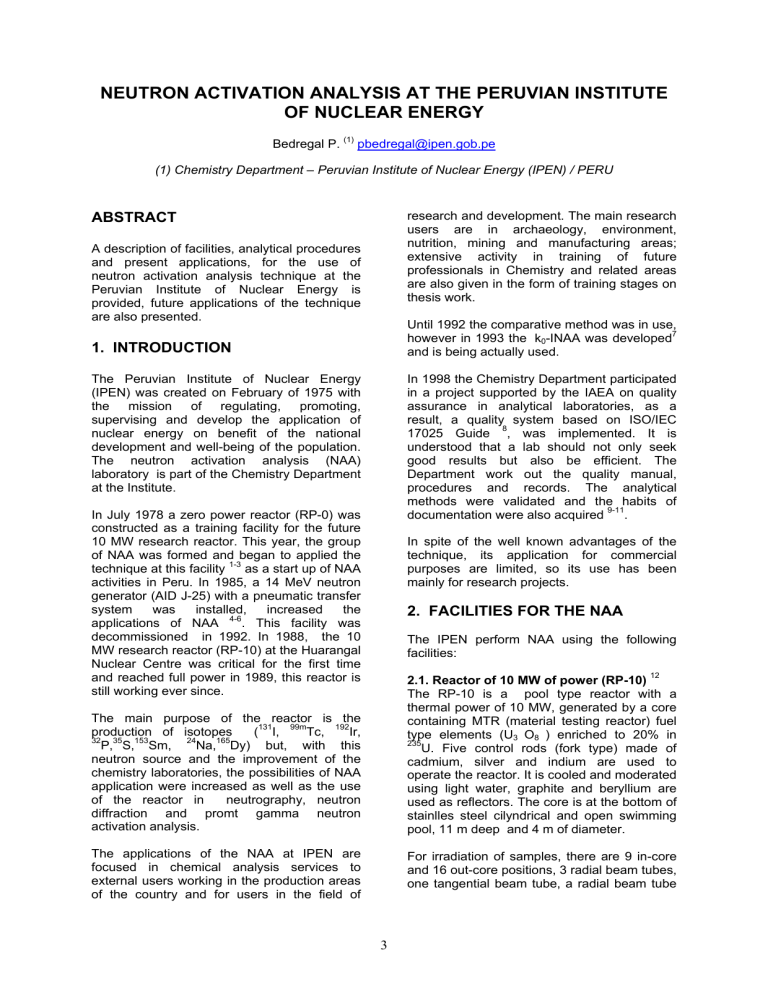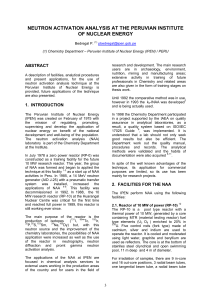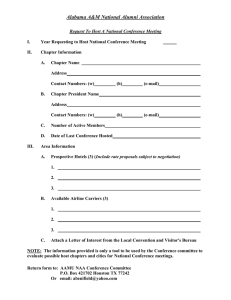
NEUTRON ACTIVATION ANALYSIS AT THE PERUVIAN INSTITUTE OF NUCLEAR ENERGY Bedregal P. (1) pbedregal@ipen.gob.pe (1) Chemistry Department – Peruvian Institute of Nuclear Energy (IPEN) / PERU research and development. The main research users are in archaeology, environment, nutrition, mining and manufacturing areas; extensive activity in training of future professionals in Chemistry and related areas are also given in the form of training stages on thesis work. ABSTRACT A description of facilities, analytical procedures and present applications, for the use of neutron activation analysis technique at the Peruvian Institute of Nuclear Energy is provided, future applications of the technique are also presented. Until 1992 the comparative method was in use, however in 1993 the k0-INAA was developed7 and is being actually used. 1. INTRODUCTION In 1998 the Chemistry Department participated in a project supported by the IAEA on quality assurance in analytical laboratories, as a result, a quality system based on ISO/IEC 17025 Guide 8, was implemented. It is understood that a lab should not only seek good results but also be efficient. The Department work out the quality manual, procedures and records. The analytical methods were validated and the habits of documentation were also acquired 9-11. The Peruvian Institute of Nuclear Energy (IPEN) was created on February of 1975 with the mission of regulating, promoting, supervising and develop the application of nuclear energy on benefit of the national development and well-being of the population. The neutron activation analysis (NAA) laboratory is part of the Chemistry Department at the Institute. In July 1978 a zero power reactor (RP-0) was constructed as a training facility for the future 10 MW research reactor. This year, the group of NAA was formed and began to applied the technique at this facility 1-3 as a start up of NAA activities in Peru. In 1985, a 14 MeV neutron generator (AID J-25) with a pneumatic transfer system was installed, increased the applications of NAA 4-6. This facility was decommissioned in 1992. In 1988, the 10 MW research reactor (RP-10) at the Huarangal Nuclear Centre was critical for the first time and reached full power in 1989, this reactor is still working ever since. In spite of the well known advantages of the technique, its application for commercial purposes are limited, so its use has been mainly for research projects. 2. FACILITIES FOR THE NAA The IPEN perform NAA using the following facilities: 2.1. Reactor of 10 MW of power (RP-10) 12 The RP-10 is a pool type reactor with a thermal power of 10 MW, generated by a core containing MTR (material testing reactor) fuel type elements (U3 O8 ) enriched to 20% in 235 U. Five control rods (fork type) made of cadmium, silver and indium are used to operate the reactor. It is cooled and moderated using light water, graphite and beryllium are used as reflectors. The core is at the bottom of stainlles steel cilyndrical and open swimming pool, 11 m deep and 4 m of diameter. The main purpose of the reactor is the production of isotopes (131I, 99mTc, 192Ir, 32 35 153 24 165 P, S, Sm, Na, Dy) but, with this neutron source and the improvement of the chemistry laboratories, the possibilities of NAA application were increased as well as the use of the reactor in neutrography, neutron diffraction and promt gamma neutron activation analysis. The applications of the NAA at IPEN are focused in chemical analysis services to external users working in the production areas of the country and for users in the field of For irradiation of samples, there are 9 in-core and 16 out-core positions, 3 radial beam tubes, one tangential beam tube, a radial beam tube 3 for neutrography, a thermal column and a pneumatic system. 200 mg sample are placed in polyethylene vials (previously washed with nitric acid) and sealed under heat. Sodium comparator is prepared depositing 2500 μg of sodium standard solution in the vial, that contains 50 mg of cellulose, then it is evaporated under IR lamp and finally sealed using heat. Sample and comparator are packed in a polyethylene capsule to be irradiated for 10 minutes. After 900 seconds of decay time, samples are counted for 800 to 1200 seconds. Sodium comparator is counted for 500 to 800 seconds, after 2 hours of decay time (using the same sample geometry, 13.5 cm). The whole data is registered and the concentration calculated using an in house, Lab Windows based software. Elemental concentrations are calculated by software which was developed in our laboratory, using the values of nuclear constants published by DECORTE and collaborators16. Dy, Ti, Mg, Mn, Na, V, Al and Ca are analized using this procedure. 2.2. Irradiation facilities For the irradiation of samples in the RP-10, a pneumatic rabbit system was installed, which consist of a PVC tube (50 m of length and 27 mm of internal diameter), connected to an Al tube of 10,5 m to the irradiation position. The tube is made of 99.7% purity aluminium inserted in an external position of the reactor core (A-1), which is at 17.9 cm from the closest fuel. The flux at this is 2.6 .1013 n.cm-2s-1. The transfer time of samples is about 12 seconds. Samples are sent into polyethylene capsules of 4.75 cm length and 1.5 cm inner diameter. The vials containing samples are made of polyethylene with 1.14 cm external diameter. The vials are irradiated for a maximum time of 30 minutes. For irradiation times longer than two hours the in core position (I-9) is used. At this position the thermal flux is 4.1013n.cm-2s-1. The samples are packed in small polyethylene bags of 1.5x1.5 cm and irradiated in aluminium cans of 6.11 cm in length and 2 cm of internal diameter with a pile up capacity of 10-12 samples. 3.2. Determination of intermediate and long lived radionuclides by k0-INAA, using pneumatic system Sample and comparator are prepared as described above, irradiated between 1800 to 2400 seconds and measured for the first time during 5000 to 7000 s after a 5 day decay in order to determined As, Br, Sm, Yb, La, Sc, Np, K, Na, Fe, Sb. After 10 to 20 days of decay time, a second measurement is made for 10000 to 20000 seconds to determine Ba, Cr, Ce, Co, Cs, Fe, Pa, Hf, Rb, Sc, y Zn. Sodium comparator is counted to the same geometry for 500 to 800 s. The whole data is registered and the concentration calculated using an in house, Lab Windows based software. Elemental concentrations are calculated by software which was developed in our laboratory, using the values of nuclear constants published by DECORTE and collaborators. 2.3. Measurement facilities The laboratory has two gamma ray spectrometers available for NAA that are installed in a laboratory close to the reactor. One of Ge detector has 15% of relative efficiency and 1.8 keV resolution at the 1332 keV line of 60Co. This spectrometry gamma system is used with a MCA PC card linked to a NIM ADC and the sample changer. The second Ge detector has 12% of relative efficiency and 1.8 keV of resolution for the 1332 keV line of 60Co. The dbGamma program ® used for data processing. 13 , version 5. is 3.3. k0-INAA of intermediate and long lived radionuclides, using in core irradiation Zirconium and gold are used for the determination of thermal to epithermal ratio (f) and the α parameter. An aliquot of standard solution of each element, is deposited on a good quality filter paper and dried, using a infrared lamp. Similarly, sodium comparators are obtained by depositing 50 μL of a 10 mg.mL-1 solution. The pieces of dry paper are placed inside small polyethylene bags and packed in aluminium foil. The samples (about 200 – 250 mg) are weighed and sealed in polyethylene bags. Samples, flux monitors and comparators are 3. ANALYTICAL PROCEDURES The described procedures using the pneumatic system, are validated 14-15 for the analysis of geological samples such as rock, soil, sediment, clay as well as archaeological ceramics, biological samples are in process. The procedure for in core irradiation for biological and geological samples are in the stage of validation. 3.1. Determination of short lived radionuclides by k0-INAA, using pneumatic system 4 alternately piled inside aluminium irradiation cans. The irradiation is carried out for 8 hours in one of the core positions of the 10 MW reactor. Flux monitors and comparators are measured after three and six days respectively, while samples are measured after 7 days for intermediate life radionuclides and 21 days for long life radionuclides. The main goal is to ensure the accuracy of the data produced, and hence their comparability17. The laboratory applies the following means to achieve accuracy in the analytical results: a) Existence of a quality manual; where we have established the mission of the Chemistry Department and the quality policy as well as the technical procedures. b) Trained personnel prepared through specialized courses. c) Good housekeeping of the laboratory; the control of indoor contamination in the lab is monitored constantly. A clean working area is available for handling the analytical samples. d) The use of validated methods. e) The application of statistical control methods such as the use of control charts, regression analysis, t- and F-tests, analysis of variance, etc. f) External quality assurance control; participating in proficiency tests and intercomparison rounds. g) Comparison of results against other methods; such that results can be verified by other independent methods. All methods have their own particular source of error18. h) The use of reference materials (RMs) and certified reference materials (CRMs) in chemical analysis is the most important tool, all the analysis are carried out including these RMs and CRMs with their composition similar to the composition of the unknown sample, including blanks and replicates of samples. The relative flux is recorded each 30 s, with a linear response fission chamber and a computer based data acquisition system with software built in LAB Windows CVI V. 5.0 ®. A program developed, using Excel Macros, accomplish the calculation of the corrected saturation factors, f and α parameters and concentrations. Table 1 and table 2 show an examples of the results obtained in the analysis of the frecuently used reference material, using the pneumatic system (A-1) and using a core position (I-9), respectively. Table 1. Results of NIST SRM 679 - BRICK CLAY (mg/kg ± U, 95%) _____________________________________ Element Laboratory Certified Value Value _________________________________________ Al* 10.81±0.25 11.01±0.34 Ba 452 ± 37 432.2 ± 9.8 Ce 120.5 ± 2.5 (105) Cr 125.0 ± 3.1 109.7 ± 4.9 Co 26.2 ± 0.5 (26) Cs 11.0 ± 0.4 (9.6) Dy 6.9 ± 0.5 -------Fe* 9.48 ± 0.13 9.05 ± 0.21 Hf 5.0 ± 0.2 (4.5) K* 2.4588 ± 0.034 2.133 ± 0.047 La 52.8 ± 0.8 -------Mg* 0.8448 ± 0.127 0.7552 ± 0.0088 Mn* 1715 ± 29 (1730) Na* 0.1356 ± 0.0020 0.1304 ± 0.0038 Rb 209 ± 11 (190) Sb 1.1 ± 0.1 -------Sm 10.3 ± 0.1 -------Th 16 ± 0.3 (14) Ti* 0.566 ± 0.07 0.577 ± 0.033 V 163.2 ± 8.6 -------U 3.4 ± 0.6 -------Yb 4.3 ± 0.2 -------Zn 157 ± 16 (150) _________________________________________ * Results expressed in percentage(%) ( ) Information values Table 2. Results of RM IAEA-336 (mg/kg ± IC 95%) __________________________________ Element Laboratory Certified Value Value _________________________________________ As 0.63 ± 0.13 0.63 ±(0.55-0.71) Ba 7.03 ± 2.93 6.4 ±(5.3-7.5) Br 11.7 ± 2.2 12.9 ±(11.2-14.6) Ce 1.26 ± 0.25 1.28 ±(1.11-1.45) Cr 1.24 ± 0.11 1.06 ±(0.89-1.23)* Co 0.37 ± 0.06 0.29 ±(0.24-0.34) Cs 0.11 ± 0.02 0.110 ±(0.097-0.123) Fe 397 ± 68 430 ±(380-480) K 1670 ± 298 1840 ±(1640-2040) La 0.57 ± 0.10 0.66 ±(0.56-0.76) Na 300 ± 50 320 ±(280-360) Rb 1.75 ± 0.64 1.76 ±(1.54-1.98)* Sb 0.06 ± 0.02 0.073 ±(0.063-0.083) Sc 0.17 ± 0.03 0.17 ±(0.15-0.19)* Se 0.24 ± 009 0.22 ±(0.18-0.26) Sm 0.11 ± 0.02 0.106 ±(0.092-0.120) Yb 0.040 ± 0.005 0.037 ±(0.025-0.049)* Zn 31.5 ± 5.5 30.4 ±(27.0-33.8) _________________________________________ * Information values 4. QUALITY ASSURANCE The laboratory established a Quality System that allowed us improve our laboratory practice, in order to obtain greater accuracy so the laboratory will be nationally accredited. 5 the Institute, that do not pay for the analysis. The laboratory has participated in intercomparison rounds and proficiency test to maintain a high quality level. 5. APPLICATIONS OF NAA According to laboratory records, in the last 7 years, the NAA, has been applied mainly for external customers, internal costumers, quality assurance and research projects19, as shown in table 3. 6. FUTURE APPLICATIONS Table 3. Percentage of analized samples vs application. Application External customers No. Samples (%) 8 Internal customers 18 Quality assurance 10 Research projects 64 The Peruvian Institute of Nuclear Energy has worked its strategic planning and as a consecuence the SWOT (strengths, weeknesses, opportunities and threats) analysis has been done. The authorities are demading to increse the use of the reactor, increase the income of the laboratories and increase production. NAA can contribute to the new trends with the following future applications: a. Peru is a mining country this brings the NAA an opportunity to look for strategic alliances with mining companies for the application of the technique in mineral analysis of non traditional elements. Many elements such as rare earths, nobel metals, Pd, Pt, U, Th, Ga, Zr and others, are used nowdays in technology (nano technology, for instance). Table 4. Matrix type and number of samples analized for application. Application External customers Internal customers Quality Assurance Intercomparison runs Validation Research projects Matrix Archaeological Minerals Others Lichens Water Other No. of samples (%) 57 39 4 82 13 2 Environment Geological Biological Sediment Clay Soil Archaeological Environmental Food Mineral 59 23 18 40 30 30 73 13 10 4 b. There are external users (universities, other institutes, and people interested in nuclear topics) that can be trained in the use of NAA. c. There is a need of application in multidisciplinary and inter institutional research projects under national and international cooperation. d. There is a need of quality assurance in the national laboratories, in this sense it is important to divulge trazability and the use of reference materials. The NAA laboratory has the capability to prepare these reference materials and to supply of them to the mining industry, for instance. Table 3 shows that participation in research projects has been in the last years the main source of application of the technique. Table 4 shows that lichens and archaelogical have been most analized matrices Acknowledgement This work was possible with the cooperation of the Chemical Laboratory staff, which with hard work make NAA alive in spite of economic constraints. There were efforts to disclose the technique to the society but the productive sectors of the country were not highly interested, so the ecomonic income was limited. The internal customers are students working in thesis and the workers of other Departments at 6 9) P. Bode. JRANC. Vol. 1215, N° I (1997) 51-57. 7. REFERENCES 1) R. Espinoza, P. Mendoza, M. Ramírez. Internal report. NAA using a Zero Reactor Power. 1978. 10) P. Bode. Powering the performance by eliminating of error: Quality System and Management in Analytical Laboratories. 2) B. López, R. Ochoa, R. Espinoza. Detrmination of vanadium in oil. Chemistry Sociaty of Peru. 11) P. Bode. K. Heydorn et al. Basic steps towards a self-sustainable quality system and laboratory acreditation. Accred Qual Assur 3: 197-202. Springer-Verlag. 1998. 3) F. Tenorio, P. Mendoza, R. Espinoza. Nuclear Magazine of IPEN. Vol. 3. N° 1 1986. 12) Peruvian Nuclear Information RP-10. 4) B. López, C. Poma, R. Espinoza. Determination of Al, Si, Fe and Mg in differente materials with 14 MeV neutrons. Nuclear Magazines of IPEN. Vol. 5 N° 1, 1989. 13) Dbgamma Manual. Electronique 15) Eurachem/CITAC. Quantifying Uncertainty in Analytical Measurement. Second edition. 2000. 16) F. de Corte. Habilitation Thesis, University of Ghent, Faculteit van de Wetenschappen, (1987). 6) R. Bejarano, P. Mendoza, R. Espinoza. Determination of Nitrogen and Phophorous in Kiwicha using NAA in a neutrons generator. Nuclear Magazine of IPEN. Vol. 6 N° 1, 1990. 17) Techniques and Instrumentation in Analytical Chemistry. Quality Assurance for environmental analysis. Belgium (1995). Ch.8. 7) E. Montoya. Evaluation and Standardization of NAA using k0 method at RP-10 nuclear reactor. Thesis, Master degree. Universidad Peruana Cayetano Heredia. 1995. 17025. CANBERRA Technical 14) EURACHEM. The Fitness for Purpose of Analytical Methods. A laboratory guide to method validation and related topics. 1998. 5) A. Arbildo, R. Espinoza, C. Poma, J. Eyzaguirre, H. Hinostroza. Determination of Oxigen in coal using NAA with neutrons of 14 MeV. Nuclear Magazines of IPEN. Vol. 5 N° 1, 1989. 8) ISO/IEC Guide requirements . Centre. 18) Techniques and Instrumentation in Analytical Chemistry. Quality Assurance for environmental analysis. Belgium (1995). Ch.1. General 19) Laboratory documentation. File 8. Analysis Information. 7






